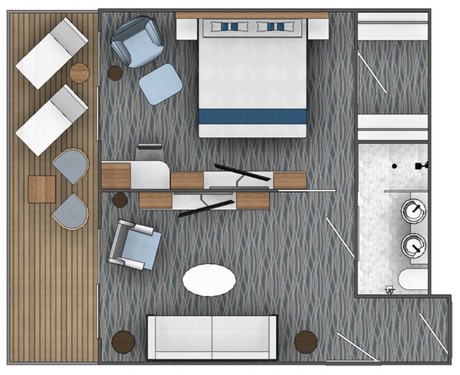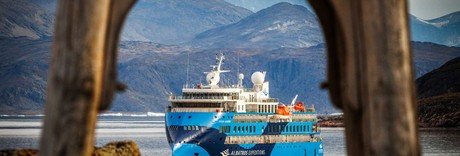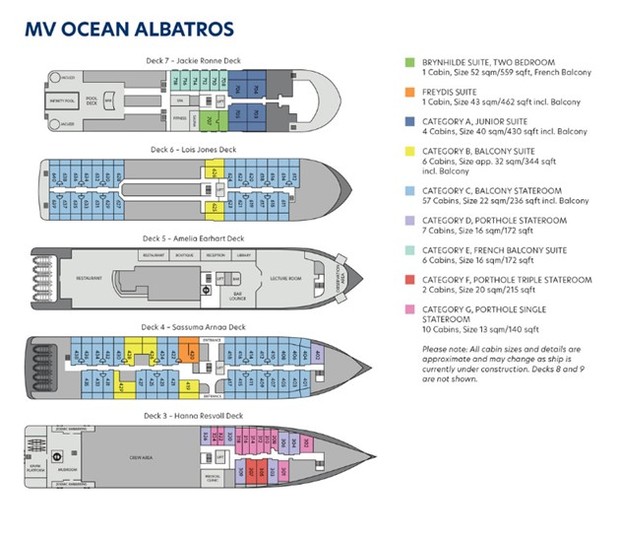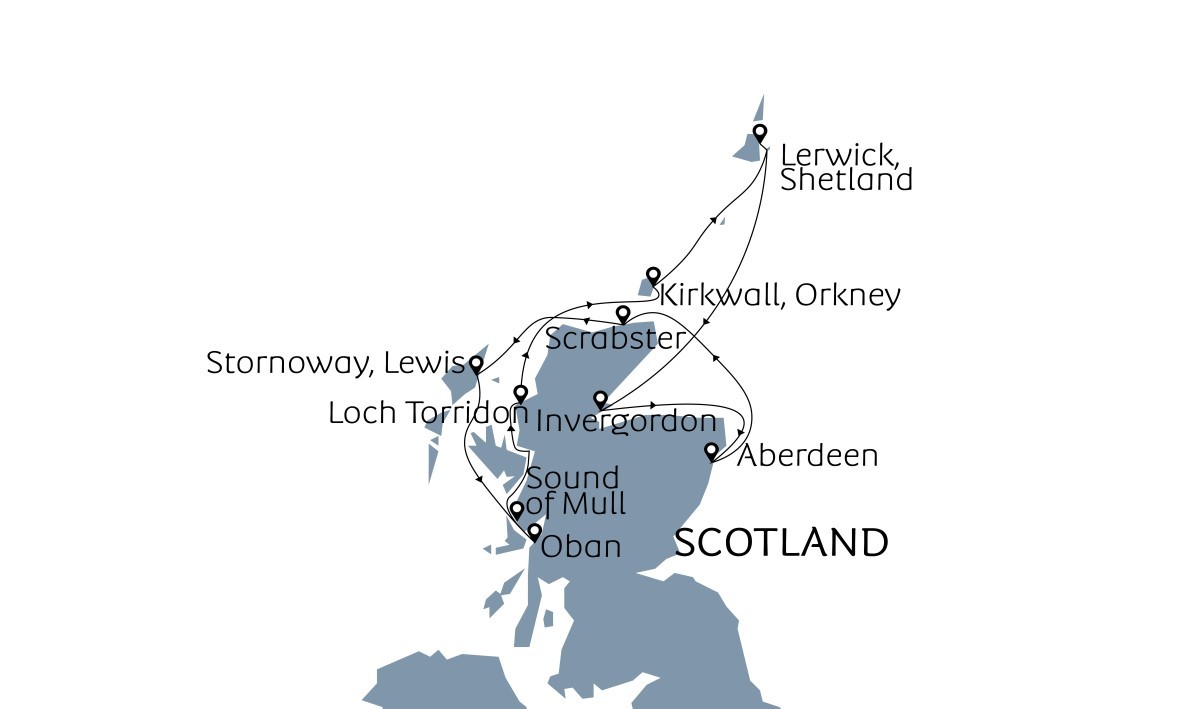
Like a tiara of emeralds, islands adorn the coastline of Scotland - and travel by sea is the only way to explore!
Scattered between the mountains and glens, the lochs and bays of Scotland lie hidden communities, historical gems and natural wonders. Each one is begging to tell you stories about a dramatic past reaching back to birth from hot molten lava millions of years ago, to millenia-old Stone Age dwellings – or just 12 years to create exquisite single malt whisky.
Embarking on Albatros’ purpose-built expedition vessel, Ocean Albatros, we head for our first landing on the Orkney Islands, steeped in ancient StoneAge mysteries and Viking heritage. From here, we will venture to Stornoway, capital of the Scottish Gaelic culture and language before experiencing the natural majesty of St Kilda, Britain's most remote outpost. Experience unforgettable encounters with the birds of Lunga, and sample excuisite Tobermory Whisky on the Isle of Mull. Witness the jaw-dropping wilderness of the Northwest Highlands and the warm hospitality of Ullapool, hike through verdant bird-filled coastlines on Shetland, and feel dwarfed by the mountains of Invergordon. During evening lectures on board, your knowledgeable Expedition Team will help to interpret these islands' fascinating geological and human history, ecology and culture.
Whether it is watching for dolphins in the Minch, gliding into quaint villages and towns, hiking the mountains and glens of the Highlands or anchoring in complete wilderness to experience abundant wildlife, there is no better way to experience Scotland than onboard an expedition cruise. This spring cruise aboard Ocean Albatros is the ultimate journey upon storied Scottish waters, complete with whisky, wildlife, and spectacular landscapes! Experience with us!
- Explore the ancient history and breathtaking landscapes of the Orkney and Shetland Isles.
- Discover the wildlife and storied scenery of Loch Torridon and Invergordon in the Scottish Highlands.
- Experience the vibrant culture and Norse heritage of Kirkwall and Lerwick.
Prices quoted here are often dependent on currency fluctuations. Please check with (01432 507450 or [email protected]) for the very latest price, which may well be cheaper than the one advertised here.









Prices quoted here are often dependent on currency fluctuations. Please check with (01432 507450 or [email protected]) for the very latest price, which may well be cheaper than the one advertised here.









Our journey begins in Aberdeen, where MV Ocean Albatros awaits in the city's bustling docks. Aberdeen, the Scottish city of adventure, is known for its many titles - the most famous being the Granite City. With its glittering Victorian buildings, it's easy to see why the city was once the world's granite-export capital. Today, the city is the epicenter of the British energy industry and a lively cultural hub, with an exceptional variety of museums, galleries, theatres, shops, cafes, and restaurants for visitors to discover.
In the afternoon, embark Ocean Albatros and make yourself at home in your confortable stateroom. After the mandatory security review and drill, we sail out along the coast of North East Scotland.
Sitting at the northernmost tip of Great Britain, Scrabster is Britain's northernmost mainland port, adjacent to the town of Thurso. The town is further north than the southern coast of Norway, and the surrounding scenery is correspondingly green, windswept and wild. While at a first glance, Scrabster may seem remote and isolted, it is surprisingly well-connected. Scrabster is the home port of the Hamnavoe, one of the Northlink ferries connecting Stromness on Orkney with the British mainland, and cargo vessels regularly depart from the port bound for Norway, Shetland and the Faroe Islands.
A stone's throw from Scrabster lies John o' Groats, the traditional northernmost point of mainland Britain (although nearby Dunnet Head is actually further north). Thousands of people have set off from this lonely windswept promontory bound for the Lizard on the southern tip of Cornwall - Britain's traditional southernmost point, 1,410km away. It is not uncommon to see police officers in the area, warily eying motorists, many of whom will attempt to break the speed record to Cornwall (and, by necessity, several traffic laws in the process)!
Near John o' Groats lies the Castle of Mey, a rambling stone residence constructed in the late 16th Century. The castle was a lonely and remote outpost (even for the Highlands of Scotland) until Queen Elizabeth The Queen Mother, widow of King George III and mother of Queen Elizabeth II, fell in love with it in the 1960s and set about restoring it for her own use. After her death, the castle has been managed by a charity, and welcomes visitors throughout summer - except of course when King Charles III is in residence!
From Scrabster, we navigate through the infamous Minch to the remote string of islands known as the Outer Hebrides. Here lies the Isle of Lewis, a rugged and bleakly beautiful land of heather and moor, loch and stream, home to the harbor town of Stornoway. Isolated from the Scottish mainland, Lewis is one of the few remaining strongholds of the Scottish Gaelic language, an ancient tongue closely related to its Celtic cousins: Irish, Welsh and Breton.
The third largest island town in Scotland (after Kirkwall and Lerwick), life in Stornoway centers around the town harbour. Here, sleek modern energy industry vessels float alongside traditional fishing boats. Expect to hear fishermen chatting in Gaelic, tossing fish ashore to be served in harbourside restaurants; you may smell peat smoke on the breeze, a vital ingredient in the islands' legendary kippers and smoked salmon.
Outside of Lewis lies mile upon mile of some of Scotland's most stunning scenery, as well as ancient gems such as the Neolithic Calanish Standing Stones. Closer to town lie more modern monuments such as Lews Castle, a grand stately home with a fascinating history. Stornoway town centre holds an excellent range of boutique shops, many selling Harris Tweed - one of the Hebrides' most famous products.
During the morning, join your expedition team out on deck as Ocean Albatros cruises through the Sound of Mull, one of Britain's most spectacular waterways. Separating the Isle of Mull from the Scottish mainland, the Sound of Mull is lined by wild windswept mountains, dripping forests, and tiny colourful communities. Be sure to look to the northern side of the Sound on the approach to Oban to see the famous Lismore Lighthouse, as well as on the water. The cold calm waters of the Sound of Mull are home to a plethora of wildlife, including dolphins, otters and even basking sharks!
Nestled deep in the maze of islands and waterways of the Inner Hebrides lies Oban, Scotland's island gateway. The town has a population of around 8000 residents, but this can more than triple during the busy summer period, as visitors come and go from the Scottish isles or explore around Oban itself. To the north of Oban lies Fort William and the Great Glen; to the west lie the majestic inner hebrides; to the south lies Loch Lomond and the Trossacks and the great city of Glasgow, and to the East lies mile upon mile of unspoilt Highland wilderness. Oban is famous for its culinary scene - the rich waters of the Inner Hebrides nourish a huge variety of shellfish, and salmon farms can be found in almost every bay. The smoked salmon produced locally is exported worldwide, however it is best enjoyed overlooking the waters where it was farmed - ideally washed down with a smoky local whisky!
Upon arriving in this spectacular waterway, visitors could be forgiven for assuming they had arrived in the fjords of Norway - the stunning steep sides of Loch Torridon share a common origin, having been scraped out of the landscape by passing glaciers over thousands of years. However, the rocks surrounding Loch Torridon tell a story which goes even further back into Earth's past. It was here that early geologists puzzled over the origin of the varied and contorted rocks of the Scottish Highlands, which have more in common with those found in Greenland than with the rest of Europe. The story told by the rocks reaches back 3 billion years, documenting the opening and closing of generations of oceans, the rise and fall of mountain rainges, and even a meteorite impact around 1.2 billion years ago.
The landscape of Loch Torridon easily matches its storied geological history. Bald mountains, often snow-capped even in summer, stand isolated amid rolling hills, as though forgotten by the passing of time. Wind-crippled trees, bent by the ferocious weather of the northwest highlands seem sculpted by inhuman hands. Steely waters hide a huge variety of wildlife, including otters, seals and dolphins. Join your Expedition Team to take a Zodiac cruise through this staggering landscape, and hunt for Scottish wildlife. Keep en eye on the skies - the craggy sides of the loch are the ideal habitat for white-tailed eagles, one of the largest and rarest birds in Britain.
During the night, Ocean Albatros will navigate around Cape Wrath to arrive at the port of Kirkwall on the breezy Orkney Isles, situated off the northern coast of Scotland. Roughly translated from Old Norse as "Seal Islands," Orkney is rich in wildlife and Viking history. Orkney and Shetland are relative newcomers to Scotland, having been sold by the to Scotland by Norway in 1472 as part of a royal dowry. The islands retain much of their Nordic heritage, from local slang, to place names the distinctively Nordic flag flown on the islands.
Orkney's history reaches back far further however; the rolling hills of Orkney hide a treasure trove of ancient remains reaching back to the Neolithic, with literally hundreds of sites scattered across the islands. A UNESCO World Heritage Site, the Neolithic Heart of Orkney includes monuments such as the 5000-year-old ceremonial stone Ring of Brodgar, and the touchingly domestic Neolithic village of Skara Brae. Nowhere else can visitors observe such spectacular vestiges of one of the earliest European civilizations.
Kirkwall itself is the thriving heart of the islands, and by far the largest town on Orkney. A tangle of narrow streets form the town centre, at the middle of which looms the magnificent St Magnus Cathedral, the often-gruesome history of which stretches back to the Viking era. Downtown Kirkwall is home to a plethora of independent shops selling local artworks and cosy cafes and restaurants serving hearty Scottish fare, as well as two world-renowned whisky distilleries. Increasingly, the strong ocean currents and winds around Kirkwall are turning the town into a hub for renewable energy - Orkney generates around 130% of it's own energy needs, entirely from renewable sources!
We are set to approach Lerwick, capital of Shetland in the morning. Shetland consists of more than 100 islands, of which only 15 are inhabited year-round. The islands form the northernmost part of the United Kingdom, located approximately 300 km above the Scottish mainland.
Like Orkney, the heritage of Shetland dates back to the Neolithic period, and Shetland was part of the Kingdom of Norway until the late 1400s; the Norn language, derived directly from Old Norse was spoken on the islands until the 1850s, peppering the placenames and slang of Shetland with Viking heritage. Norse connections are strong here, from the Shetland flag to the Up Helly Aa Fire Festival, held every year in midwinter. Modern Lerwick is a prosperous, bustling town, which thrives on the oil, gas and green energy industries, and increasingly on tourism. Enjoy a stroll through the town's busy high street, lined with independent shops selling local products, immerse yourself in history at the Shetland Museum and Archives, or watch the local ferries come and go from the busy harbourfront.
Shetland's history stretches much further back than the Viking period and, like Orkney, holds a plethora of fasctinating ancient sites. Many of these such as the exceptionally well-preserved and restored Broch of Clickimin can be accessed in a leisurely stroll from downtown Lerwick, along with breathtaking coastal vistas, and the chance to see wildlife including puffins, gannets, dolphins and even orcas!
Sailing through the calm waters of Cromarty Firth, the legs of gigantic oil platforms on their way to the North Sea dwarf the small town of Invergordon. Even the gigantic oil platforms however are dwarfed by the backdrop of mountains, moors and glens which lie behind the town. One of the gateways to the North Scottish Highlands, Invergordon is a surprisingly busy cruise port, receiving visitors from all over the world.
Invergordon was founded during the Victorian period, as the harbour was far superior for modern ships compared to the nearby (and much older) town of Inverness. The town expanded during the First World War as a naval base, strategically situated on several North Sea shipping routes. After the Second World War, the town's sheltered deep water port was repurposed, becoming an important hub for the oil and gas industry. Signs of the prosperity this has brought to Invergordon are cleary visible throughout the bulsting town center, which is also renowned for it's street art, with a number of massive murals depicting local history and culture scattered through the town.
Invergordon is a popular gateway to nearby Inverness, itself a gateway to the Great Glen of Scotland; most visitors however come to see the stunning views and murky waters of Loch Ness, the legendary waterway home to the fabled monster. Much more commonly seen than the monster itself are the vast flocks of waterbirds and dolphins which thrive in the waters of Cromarty Firth and the surrounding seas - keep binoculars at the ready!
During the final day of our expedition, Ocean Albatros will come alongside beneath the glittering grey granite of Aberdeen. After a hearty breakfast, bid a fond farewell to the Crew and Officers of Ocean Albatros before departing home, or for further adventures in the Scottish highlands.
Itineraries are subject to change.
Ocean Albatros

| Launch | 2021 |
|---|---|
| Cabins | 95 |
The Ocean Albatros will be deployed to a large selection of expedition cruise destinations, Antarctica, the Arctic, any various exciting new destinations in between.
With a total of 95 comfortable staterooms and suites, all with unobstructed sea view, most with their own balcony, the Ocean Albatros will definitely become one of the most popular expedition cruise vessels in the world. Like it's sistership, the Ocean Victory, it offers two restaurants, a wellness area, an Albatros Nordic Bar, an open deck dining facility, a modern lecture lounge, and other state-of-the-art amenities. The vessel will have more than a 50% lower carbon footprint than traditional expedition vessels and be one of the most environmentally friendly, implementing the Green Initiative Program, ensuring both absolute comfort and sustainability for our guests. Unlike the Ocean Victory, the Ocean Albatros will also offer a unique panorama sauna, and a total of 12 dedicated solo travel cabins without a single-supplement.
The vessel belongs to the greenest generation of cruise ships in the world. Its tier 3 compliant engines give up to 80 percent less emissions and operate on significantly lower fuel consumption.
BRIDGE
Due to its important role as a control center for all nautical and technical processes, the ship's bridge is a vital, sensitive place. Therefore, the bridge may not be accessible to the public at all times. Conditions permitting, we will be happy to welcome you into the bridge for a visit. Guests must be accompanied by the master or our expedition leader.
STATEROOM SERVICE
Your stateroom is serviced daily. We provide a turn-down service. We provide meal to room only for serious cases of guest being sick. Our suites will have VIP services.
ZODIAC LANDINGS
One feature of our expedition cruises includes landings and excursions aboard Ocean Albatros's fleet of 18 inflatable, motorized rubber "Zodiac" boats. The Zodiac brand has earned a well-deserved reputation as the sturdiest and safest small watercraft available. These boats have a low draft and great stability. Zodiacs are constructed for professional use and are outfitted with a top-quality outboard engine, yet their design minimally impacts the environment.
The Zodiacs are designed to provide unrestricted access to the world’s last great frontier. Their versatility enables us to make landfall on remote shores, cruise along awe-inspiring coastlines and share breathtakingly close encounters with whales, seals, penguins, seabirds and more. We will come within arm’s reach of icebergs and set foot on land discovered by pioneering explorers just over a century ago.
Your safety and comfort are our #1 priority, and your expedition leader will carefully plan for as many Zodiac excursions as possible, dependent upon the local weather and prevailing conditions. In each case, the expedition leader makes the final decision if the landing is possible or not. Safety regulations apply on landings. All guests receive a mandatory instruction of the safety guidelines. Life jackets are mandatory to wear.
Please note, we highly recommend the use of waterproof bags in order to protect your personal camera or binoculars, as both hands must be free of everything during boarding. Participation is fairly easy and comfortable for able-bodied guests but can be more challenging for those with physical handicaps.
GRATUITIES
Following international standards in the service industry, it is customary to leave gratuity for the ship’s crew at the end of the voyage. All gratuities will be divided among the crew. Typically, a recommended amount is approximately 13.5 USD per person per day. Gratuity is, of course, not required and any gratuity payments are voluntary.
DRESS CODE
The dress code on board is casual. Ties, jackets and evening dresses you may leave at home. It is rather more important to wear the right clothes in order to adapt to the different weather conditions. We recommend comfortable, breathable, waterproof and windproof clothing. Also, you should have a pair of gloves, thermal underwear and sturdy footwear in your luggage. For the captains and farewell cocktail, we recommend a smart casual dress style.
INTERNET / PHONE
Keep in mind, we will be cruising in a very remote region of the world. Where accessible, internet access is available for an extra charge. Mobile phone reception may be possible in select regions along our route. For further details please contact your mobile phone operator. Prices can be found in the information folder in your state room. Please ensure that your ‘Data Roaming’ function is switched off.
RECEPTION
The daily office hours of the board reception are from 06:00 until 23:00.
ALBATROS OCEAN SHOP
The selection of items available for purchase varies by ship, and may include a range of warm and practical clothing, as well as souvenirs, local arts and postcards at reasonable prices. A small selection of soap, toothpaste and other personal effects are also sold.
HEALTH / MEDICAL EMERGENCY
Each of our vessels has a small medical facility equipped with the necessary equipment and medicine to handle small emergencies. The infirmary is always staffed by a professionally licensed, English-speaking physician and nurse. Should a serious incident occur, the nearest hospital will be contacted. All guests must have personal travel/health insurance.
Although we do not have an official requirement regarding personal fitness, you should be able to move on board and ashore without the help of others. Please be aware that the ship does not provide wheelchair accessible state rooms.
Due to safety reasons a cruise is only possible for pregnant women until the 24th week of pregnancy. The state of pregnancy must be presented by a medical certificate.
PHYSICAL DISABILITIES / WHEELCHAIR ACCESSIBILITY
Guests with physical disabilities are recommended to travel with an accompanying person. The processes on board should be handled without external help. The gangway can be – depending on the individual disability – a challenge. The angle of inclination of the gangway varies due to tide and different circumstances in the respective port. Please note that the guest’s participation in shore excursions as well as the (dis-)embarkation by Zodiac can be denied by the expedition leader due to security reasons. The instructions of the expedition leader must be followed. The ship is not suitable for wheelchairs.
SEASICKNESS / STABILISATORS
The ship is equipped with stabilizers in order to reduce the ship’s roll. However, these expeditions are hosted in remote regions, and it is possible to periodically encounter changing environments and climate patterns, including rough seas and large swells. Seasickness patches (Scopoderm or similar) work solely or in part to help cure nausea for most people. These medicines can cause sleepiness. If you are prone to motion sickness, consult with your doctor prior to departure to help ensure your comfort while travelling.
SPECIAL DIETARY REQUESTS
All meals on board the vessel is chef-prepared. If you have special dietary requirements (food allergies, intolerances, health conditions or religious preferences), please inform us as early as possible - ideally, no later than 2 weeks before departure. In order to ensure efficient service, please re-confirm your requirements with the crew upon boarding the ship.
LAUNDRY
If you wish to have some laundry done while aboard the ship, laundry service is available for an additional fee.



